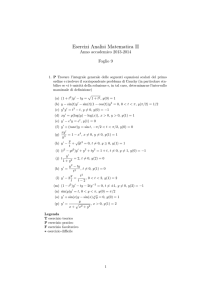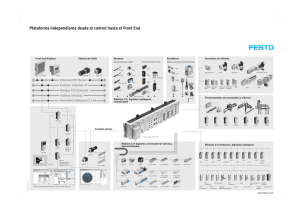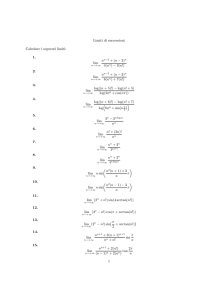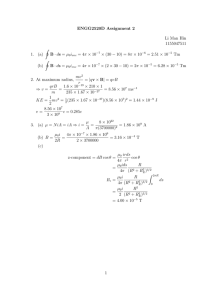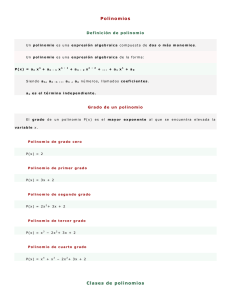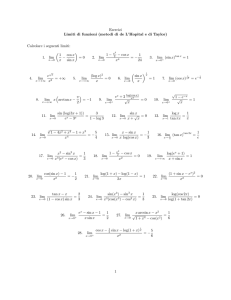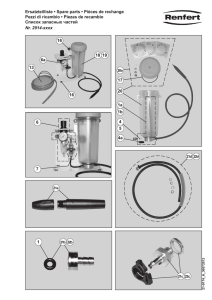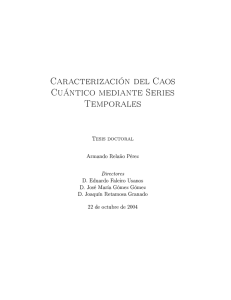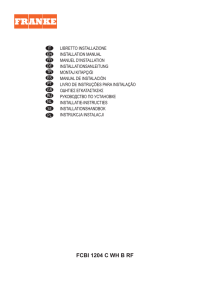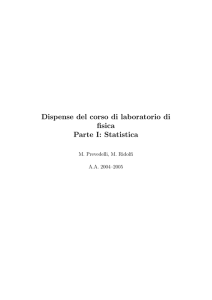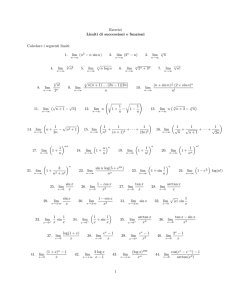PREREQUISITI • Equazioni 1) x + 13 − 2(x − 1) = 3(x + 2) − 4 2) 12x
Anuncio
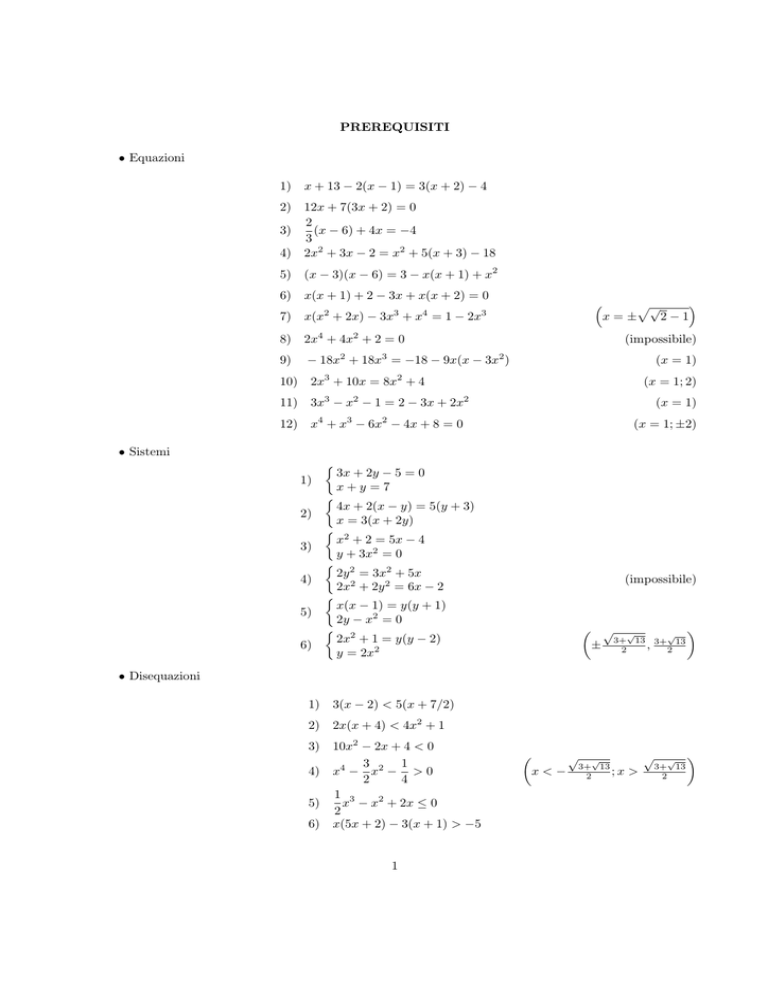
PREREQUISITI • Equazioni 1) x + 13 − 2(x − 1) = 3(x + 2) − 4 2) 4) 12x + 7(3x + 2) = 0 2 (x − 6) + 4x = −4 3 2x2 + 3x − 2 = x2 + 5(x + 3) − 18 5) (x − 3)(x − 6) = 3 − x(x + 1) + x2 6) x(x + 1) + 2 − 3x + x(x + 2) = 0 7) x(x2 + 2x) − 3x3 + x4 = 1 − 2x3 8) 2x4 + 4x2 + 2 = 0 9) − 18x2 + 18x3 = −18 − 9x(x − 3x2 ) 3) 3 x=± 2x + 10x = 8x + 4 11) 3x3 − x2 − 1 = 2 − 3x + 2x2 4 3 ½ 1) ½ 2) ½ 3) ½ 4) ½ 5) ½ 6) ´ 2−1 (impossibile) (x = 1) (x = 1; 2) (x = 1) 2 x + x − 6x − 4x + 8 = 0 • Sistemi p√ 2 10) 12) ³ (x = 1; ±2) 3x + 2y − 5 = 0 x+y =7 4x + 2(x − y) = 5(y + 3) x = 3(x + 2y) x2 + 2 = 5x − 4 y + 3x2 = 0 2y 2 = 3x2 + 5x 2x2 + 2y 2 = 6x − 2 (impossibile) x(x − 1) = y(y + 1) 2y − x2 = 0 µ √ √ ¶ √ 3+ 13 3+ 13 ± , 2 2 2x2 + 1 = y(y − 2) y = 2x2 • Disequazioni 1) 3(x − 2) < 5(x + 7/2) 2) 2x(x + 4) < 4x2 + 1 10x2 − 2x + 4 < 0 3 1 4) x4 − x2 − > 0 2 4 1 3 5) x − x2 + 2x ≤ 0 2 6) x(5x + 2) − 3(x + 1) > −5 3) 1 µ √ x<− √ 3+ 13 ;x 2 √ > √ ¶ 3+ 13 2 Micol Amar ANALISI MATEMATICA I - 1999/2000 • Divisione di polinomi (riscrivere le seguenti espressioni razionali fratte come somma di un polinomio e di una razionale fratta, in cui il grado del polinomio a numeratore sia minore del grado del polinomio a denominatore) √ ¢ ¡√ 3x2 − 2y 2 √ 1) √ 3x − 2y 3x + 2y x3 + y 3 2) (x + y) 2 x − xy + y 2 ³ ´ √ x4 + 2x2 + x − 4 (2−3/ 2)x2 +x−4 √1 x + √ √ 3) 3 2 2x +3x 2x3 + 3x ´ ³ 4 x +1 4) x2 − 1 + x22+1 2 x +1 • Equazioni e disequazioni razionali fratte 6(x − 2) 1) =5 x+1 4x 4 2) + 10 = x−1 x−1 4 3 = 3) x+2 x−2 x+2 4) =x x−3 x2 + 1 − 2x 1−x 5) = (impossibile) 4x + 8 x − 2 + x2 3x2 6) =2 2 x −x−1 3(x − 2) ≥2 7) x+1 x−1 8) ≤2 2+x 5 10 9) > x−4 x+4 1 10) < −(x2 + 2) (impossibile) x2 + 1 2x + 1 2 11) > (x 6= 1) (x − 1)2 x−1 x3 − 2x2 + x − 2 1 12) > (x > −1; x 6= 0, 2) x2 − x − 2 x+1 • Proprietà delle potenze (x, y, z > 0) x3 · x7 =? x15 2) [(x4 )7 · x2 ]1/2 =? 1) 3) 4) 5) 6) (x3 · y 3 )2 =? z6 x2 + x3 =? x1/2 4 4 x +y =? (xy)3 p√ √ x· 3x √ =? 7 x4 2 prerequisiti • Identità fondamentali della trigonometria sin2 θ + cos2 θ = 1 sin(−θ) = − sin θ cos(−θ) = cos θ sin 2θ = 2 sin θ cos θ cos 2θ = cos2 θ − sin2 θ = 1 − 2 sin2 θ = 2 cos2 θ − 1 sin(θ ± φ) = sin θ cos φ ± cos θ sin φ cos(θ ± φ) = cos θ cos φ ∓ sin θ sin φ r θ 1 − cos θ sin = ± 2 2 r θ 1 + cos θ cos = ± 2 2 θ 2 tan 2 sin θ = 1 + tan2 θ2 cos θ = θ 2 2 θ tan 2 1 − tan2 1+ θ±φ θ∓φ cos 2 2 θ+φ θ−φ cos θ + cos φ = 2 cos cos 2 2 θ+φ θ−φ cos θ − cos φ = −2 sin sin . 2 2 • Equazioni e disequazioni trigonometriche sin θ ± sin φ = 2 sin 1) sin2 θ + 3 sin θ = −2 2) cos θ + 3 sin2 θ = 0 3) 2 cos 2θ + 2 sin θ = 2 4) cos θ + sin θ tan θ > 1 sin θ sin θ + ≤1 cos θ − sin θ cos θ + sin θ sin2 θ ≥ 1 + cos2 θ . 5) 6) • Geometria analitica (disegnare i seguenti luoghi geometrici) 1) 3y + 5x + 2 = 0 2) 6x2 + 3(y − 1)2 − 1 = 0 3) x2 + y 2 + 2x − 2 = 0 4) 36x2 + 12x − y 2 + 4 = 0 5) 3x2 + 2y − 1 = 0 6) y 2 + 3x = 2 7) 4y + 12x = 1 8) 4x2 + 2x + 4y 2 − 2y = 3/2 9) 4x2 − y 2 + 2y = 9 . 3 Micol Amar ANALISI MATEMATICA I - 1999/2000 • Logartimi ed esponenziali ³ 2 ex 1) = e3 e2 ex 3 2 e3x e3 2) = e2x +1+x e2x 3) (10)2x + 2 · (10)x = 3 4) e 3x + 3e 3x2 e 5) 2x +e (ex )x x2 (x = 2/3; ±1) (x = 0) x > 3e + 1 µ q − log 2 ≤ 3ex 2 √ 3+ 5 2 q ≤x≤ log 2 6) e4x + e2x = e2x+2x + e2x 7) 9) log(3x2 + 2x − 1) − log(2x + 1) > 0 11) log(3x − 2) >1 log(4x − 1) 12) log3 x − 2 log x ≥ 0 3+ 5 2 (2 log 2 = log 4) (2) √ ¢ ¡ x= 8 ³ p ´ x > 2/3 log2 (6x) + 2 log2 x − log2 (3x) = 4 10) (x > 0) ¶ √ (x = 0; 1) log 10 + log 2 − log 5 =? 3 log 2 − log 10 =? 1/2(log 4 − log 5) 8) √ ´ 1± 21 2 x= ³ √ e− 2 (impossibile) √ ´ ≤ x ≤ 1; x ≥ e 2 • Valore assoluto 1) |x + 10| = −3 (impossibile) √ ¢ ¡ x = −1 ± 5 2) |x2 + 2x| = 4 3) |x2 + 4x| = 4x − 1 (impossibile) 4) |x2 + 2x + 1| < 0 (impossibile) 2 5) |x + 1| > 1/2 (∀x) 6) |x + 2| ≤ |x + 3| (x ≥ −5/2) 2 7) |x + 4| ≤ x + 2 8) |x2 − 2| > x − 1 9) |x + 12| < 1 ³ x< (x ≤ −1; x ≥ 2) √ ´ > 1+2 5 √ −1+ 13 ;x 2 (−13 < x < −11) • Equazioni e disequazioni irrazionali 1) 2) 3) 4) 5) 6) 7) p x2 + 2x = √ √ 3 ³ x+1 x−4=4−x p x2 + 1 = 2x + 1 p x4 + 1 ≥ −7, 5 p x2 − 3x + 5 ≤ x + 3 p 3 x3 − 8 ≥ x − 2 p x3 + 3x2 + 3x + 1 ≥ x + 1 4 x= √ ´ −1+ 5 2 (x = 4) (x = 0) (∀x) (x ≥ −4/9) (x ≤ 0; x ≥ 2) (x ≥ 0; x = −1) prerequisiti 8) √ 3 x + 125 < x + 5 r 1 √ 4 9) x+ > 5−x 2 √ √ 10) x − 1 + −x + 3 ≤ 4 p p 11) x2 − 3x + 1 + x2 − 3 < −2 r 18 − x 12) > 2x − 3 x+2 5 ³ √ 11− 23 2 (x > 0) ´ <x≤5 (1 ≤ x ≤ 3) ³ (impossibile) √ ´ −2 < x < 1+2 15
